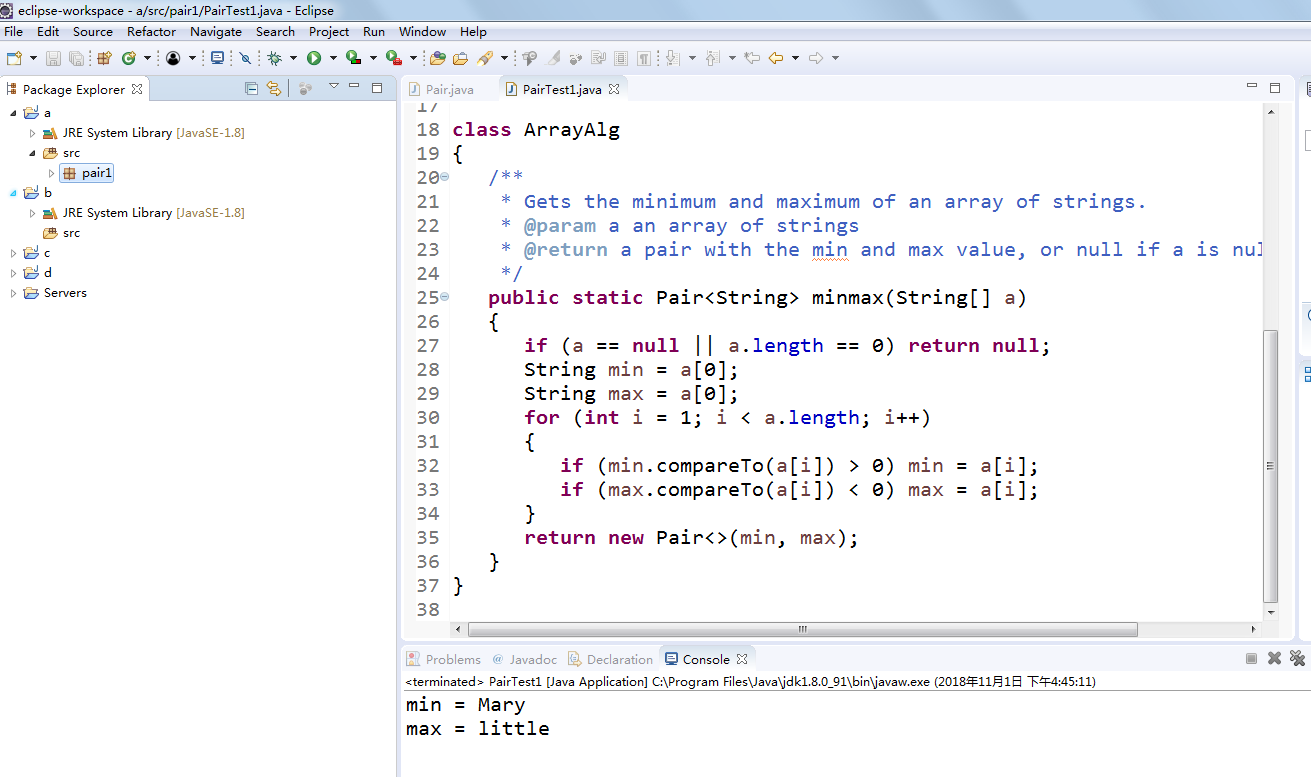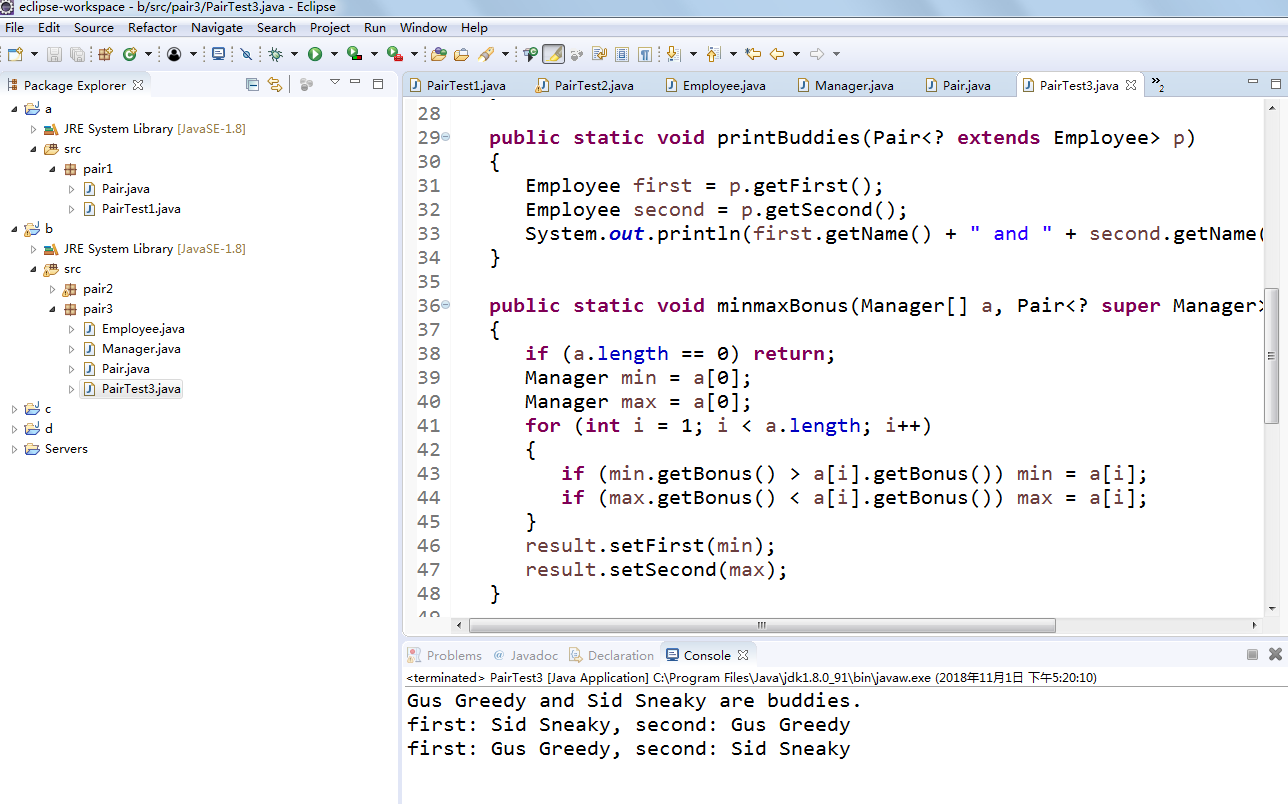实验十 泛型程序设计技术
一 理论部分
1.泛型:参数化类型,在定义类、接口、方法时通过类型参数指示将要处理的对象类型
2.泛型程序设计意味着编写的代码可以被许多不同类型的对象所重用
3.定义简单泛型类:
(1)一个泛型类就是具有一个或多个类型变量的类,即创建用类型作为参数的类
(2)以Pair类为例:public class Pair<T>
{
......
}
Pair类引入了一个类型变量T,用尖括号(<>)括起来,并放在类名的后面
(3)泛型类可以有多个类型变量。例如,可以定义Pair类,其中第一个域和第二个域使用不同的类型:public class Pair<T,U> { ... }
(4)类定义中的类型变量指定方法的返回类型以及域和局部变量的类型
(5)实例化泛型对象时,一定要在类名后面指定类型参数的值,一共要有两次书写,例如:TestGeneric<String,String> t=new TestGeneric<String,String>();
4.泛型方法:
(1)定义泛型方法时注意,类型变量放在修饰符(public static)的后面,返回类型的前面
(2)泛型方法可以定义在普通类中,也可以定义在泛型类中
(3)当调用一个泛型方法时,在方法名前的尖括号中放入具体的类型
5.泛型接口的定义与实现:
(1)定义:public interface IPool<T>
{
T get();
int add(T t);
}
(2)实现:public class GenericPool<T> implements IPool<T> { ... }
public class GenericPool implements IPool<Account> { ... }
6.类型变量的限定:
(1)定义泛型变量的上界(用extends)
<T extends BoundingType>表示T是绑定类型的子类型。T和绑定类型可以是类,也可以是接口
一个类型变量或通配符可以有多个限定,例如:T extends Comparable & Serializable(限定类型用“&”分隔)
(2)定义泛型变量的下界(用super) 例如:<? super T>
7.泛型类的约束与局限:
(1)不能用基本类型实例化类型参数
(2)运行时类型查询只适用于原始类型
(3)不能抛出也不能捕获泛型类实例
(4)参数化类型的数组不合法
(5)不能实例化类型变量
(6)泛型类的静态上下文中类型变量无效
(7)注意擦除后的冲突
8.泛型类型的继承规则:Java中的数组是协变的,但泛型类不是协变的
9.通配符类型:(?,任何类型;T,某一种类型)
(1)单独的?,用于表示任何类型
(2)?extends type,表示带有上界
(3)? super type,表示带有下界
10.(1)通配符的类型限定: Pair<? extends Employee>
Pair<? super Manager>
(2)无限定通配符:Pair<?>(Pair<?>与Pair的不同在于:可以用任意Object对象调用原始的Pair类的setObject方法)
二 实验部分
1、实验目的与要求:
(1) 理解泛型概念;
(2) 掌握泛型类的定义与使用;
(3) 掌握泛型方法的声明与使用;
(4) 掌握泛型接口的定义与实现;
(5)了解泛型程序设计,理解其用途。
2、实验内容和步骤
实验1: 导入第8章示例程序,测试程序并进行代码注释。
测试程序1:
l 编辑、调试、运行教材311、312页 代码,结合程序运行结果理解程序;
l 在泛型类定义及使用代码处添加注释;
l 掌握泛型类的定义及使用。
package pair1;
/**
* @version 1.00 2004-05-10
* @author Cay Horstmann
*/
public class Pair<T> //引入类型变量T
{
private T first;
private T second;
public Pair() { first = null; second = null; }
public Pair(T first, T second) { this.first = first; this.second = second; }
public T getFirst() { return first; }
public T getSecond() { return second; }
public void setFirst(T newValue) { first = newValue; }
public void setSecond(T newValue) { second = newValue; }
}
package pair1;
/**
* @version 1.01 2012-01-26
* @author Cay Horstmann
*/
public class PairTest1
{
public static void main(String[] args)
{
String[] words = { "Mary", "had", "a", "little", "lamb" };
Pair<String> mm = ArrayAlg.minmax(words);
System.out.println("min = " + mm.getFirst());
System.out.println("max = " + mm.getSecond());
}
}
class ArrayAlg//泛型方法
{
/**
* Gets the minimum and maximum of an array of strings.
* @param a an array of strings
* @return a pair with the min and max value, or null if a is null or empty
*/
public static Pair<String> minmax(String[] a)
{
if (a == null || a.length == 0) return null;
String min = a[0];
String max = a[0];
for (int i = 1; i < a.length; i++)
{
if (min.compareTo(a[i]) > 0) min = a[i];
if (max.compareTo(a[i]) < 0) max = a[i];
}
return new Pair<>(min, max);
}
}

测试程序2:
l 编辑、调试运行教材315页 PairTest2,结合程序运行结果理解程序;
l 在泛型程序设计代码处添加相关注释;
l 掌握泛型方法、泛型变量限定的定义及用途。
package pair2;
import java.time.*;
/**
* @version 1.02 2015-06-21
* @author Cay Horstmann
*/
public class PairTest2
{
public static void main(String[] args)
{
LocalDate[] birthdays =
{
LocalDate.of(1906, 12, 9), // G. Hopper
LocalDate.of(1815, 12, 10), // A. Lovelace
LocalDate.of(1903, 12, 3), // J. von Neumann
LocalDate.of(1910, 6, 22), // K. Zuse
};
Pair<LocalDate> mm = ArrayAlg.minmax(birthdays);
System.out.println("min = " + mm.getFirst());
System.out.println("max = " + mm.getSecond());
}
}
class ArrayAlg
{
/**
Gets the minimum and maximum of an array of objects of type T.
@param a an array of objects of type T
@return a pair with the min and max value, or null if a is
null or empty
*/
public static <T extends Comparable> Pair<T> minmax(T[] a) //泛型方法,有上界约束
{
if (a == null || a.length == 0) return null;
T min = a[0];
T max = a[0];
for (int i = 1; i < a.length; i++)
{
if (min.compareTo(a[i]) > 0) min = a[i];
if (max.compareTo(a[i]) < 0) max = a[i];
}
return new Pair<>(min, max);
}
}

测试程序3:
l 用调试运行教材335页 PairTest3,结合程序运行结果理解程序;
l 了解通配符类型的定义及用途。
package pair3;
/**
* @version 1.01 2012-01-26
* @author Cay Horstmann
*/
public class PairTest3
{
public static void main(String[] args)
{
Manager ceo = new Manager("Gus Greedy", 800000, 2003, 12, 15);
Manager cfo = new Manager("Sid Sneaky", 600000, 2003, 12, 15);
Pair<Manager> buddies = new Pair<>(ceo, cfo); //类型变量
printBuddies(buddies);
ceo.setBonus(1000000);
cfo.setBonus(500000);
Manager[] managers = { ceo, cfo };
Pair<Employee> result = new Pair<>();//也可以用Manager
minmaxBonus(managers, result);
System.out.println("first: " + result.getFirst().getName()
+ ", second: " + result.getSecond().getName());
maxminBonus(managers, result);
System.out.println("first: " + result.getFirst().getName()
+ ", second: " + result.getSecond().getName());
}
public static void printBuddies(Pair<? extends Employee> p)//上界约束
{
Employee first = p.getFirst();
Employee second = p.getSecond();
System.out.println(first.getName() + " and " + second.getName() + " are buddies.");
}
public static void minmaxBonus(Manager[] a, Pair<? super Manager> result)//采用通配符来定义第二个类型变量result
{
if (a.length == 0) return;
Manager min = a[0];
Manager max = a[0];
for (int i = 1; i < a.length; i++)
{
if (min.getBonus() > a[i].getBonus()) min = a[i];
if (max.getBonus() < a[i].getBonus()) max = a[i];
}
result.setFirst(min);
result.setSecond(max);
}
public static void maxminBonus(Manager[] a, Pair<? super Manager> result)
{
minmaxBonus(a, result);
PairAlg.swapHelper(result); // OK--swapHelper captures wildcard type
}
// Can't write public static <T super manager> ...
}
class PairAlg
{
public static boolean hasNulls(Pair<?> p)//?类型变量的通配符,单独的?表示任何一种类型,T表示一种未知类型
//将hasNulls转换成泛型方法
//测试一个pair是否包含一个null引用
{
return p.getFirst() == null || p.getSecond() == null;
}
//编写一个交换成对元素的方法
public static void swap(Pair<?> p) { swapHelper(p); }
public static <T> void swapHelper(Pair<T> p)//泛型方法
{
T t = p.getFirst();//保存第一个元素
p.setFirst(p.getSecond());
p.setSecond(t);
}
}

实验2:编程练习:
编程练习1:实验九编程题总结
l 实验九编程练习1总结(从程序总体结构说明、模块说明,目前程序设计存在的困难与问题三个方面阐述)。
总体结构说明:
主类main,子类card
模块说明:
main
package shen;
import java.io.BufferedReader;
import java.io.File;
import java.io.FileInputStream;
import java.io.FileNotFoundException;
import java.io.IOException;
import java.io.InputStreamReader;
import java.util.ArrayList;
import java.util.Arrays;
import java.util.Collections;
import java.util.Scanner;
public class Main {
/**
* 1.文件读取模块 利用ArrayList构造studentlist存放文件内容2. 创建文件字符流,分类读取文件内容 3.try/catch语句捕获异常
*/
private static ArrayList<Student> studentlist;
public static void main(String[] args) {
studentlist = new ArrayList<>();
Scanner scanner = new Scanner(System.in);
File file = new File("C:\Users\ASUS\Desktop\新建文件夹\身份证号.txt");
try {
FileInputStream fis = new FileInputStream(file);
BufferedReader in = new BufferedReader(new InputStreamReader(fis));
String temp = null;
while ((temp = in.readLine()) != null) {
Scanner linescanner = new Scanner(temp);
linescanner.useDelimiter(" ");
String name = linescanner.next();
String number = linescanner.next();
String sex = linescanner.next();
String age = linescanner.next();
String province = linescanner.nextLine();
Student student = new Student();
student.setName(name);
student.setnumber(number);
student.setsex(sex);
int a = Integer.parseInt(age);
student.setage(a);
student.setprovince(province);
studentlist.add(student);
}
} catch (FileNotFoundException e) {
System.out.println("学生信息文件找不到");
e.printStackTrace();
// 加入的捕获异常代码
} catch (IOException e) {
System.out.println("学生信息文件读取错误");
e.printStackTrace();
// 加入的捕获异常代码
}
/*
* 1.根据实验要求,选择具体操作的模块 2.利用switch语句选择具体的操作
*/
boolean isTrue = true;
while (isTrue) {
System.out.println("选择你的操作,输入正确格式的选项");
System.out.println("A.字典排序");
System.out.println("B.输出年龄最大和年龄最小的人");
System.out.println("C.寻找老乡");
System.out.println("D.寻找年龄相近的人");
System.out.println("F.退出");
String m = scanner.next();
switch (m) {
case "A":
Collections.sort(studentlist);
System.out.println(studentlist.toString());
break;
case "B":
int max = 0, min = 100;
int j, k1 = 0, k2 = 0;
for (int i = 1; i < studentlist.size(); i++) {
j = studentlist.get(i).getage();
if (j > max) {
max = j;
k1 = i;
}
if (j < min) {
min = j;
k2 = i;
}
}
System.out.println("年龄最大:" + studentlist.get(k1));
System.out.println("年龄最小:" + studentlist.get(k2));
break;
case "C":
System.out.println("老家?");
String find = scanner.next();
String place = find.substring(0, 3);
for (int i = 0; i < studentlist.size(); i++) {
if (studentlist.get(i).getprovince().substring(1, 4).equals(place))
System.out.println("老乡" + studentlist.get(i));
}
break;
case "D":
System.out.println("年龄:");
int yourage = scanner.nextInt();
int near = agenear(yourage);
int value = yourage - studentlist.get(near).getage();
System.out.println("" + studentlist.get(near));
break;
case "F":
isTrue = false;
System.out.println("退出程序!");
break;
default:
System.out.println("输入有误");
}
}
}
/*
* 对年龄数据进行相应的处理
*/
public static int agenear(int age) {
